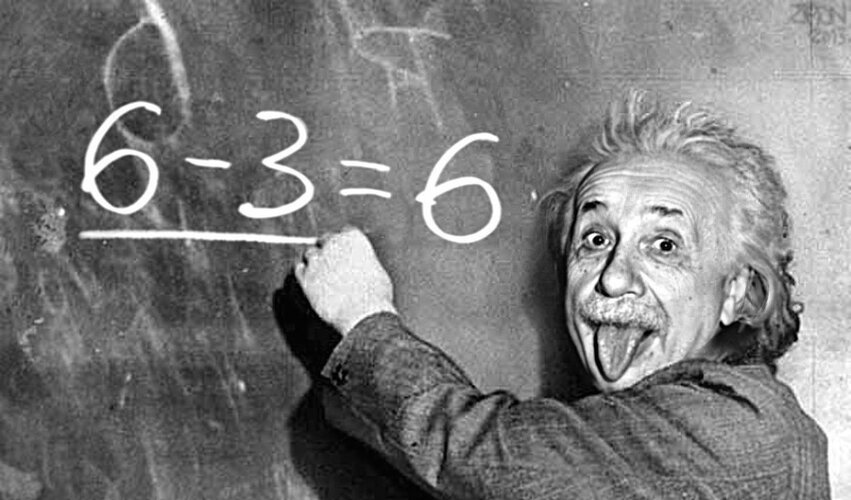You are using an out of date browser. It may not display this or other websites correctly.
You should upgrade or use an alternative browser.
You should upgrade or use an alternative browser.
Alcubierre Warp Drive starship IXS Enterprise
- Thread starter Triton
- Start date
"This is the amazing design for NASA’s Star Trek-style space ship, the IXS Enterprise"
By Abby Phillip June 11 at 4:20 PM
Source:
http://www.washingtonpost.com/news/post-nation/wp/2014/06/11/this-is-the-amazing-design-for-nasas-star-trek-style-space-ship-the-ixs-enterprise/
Artist's impressions of Alcubierre Warp Drive starship IXS Enterprise.
By Abby Phillip June 11 at 4:20 PM
Source:
http://www.washingtonpost.com/news/post-nation/wp/2014/06/11/this-is-the-amazing-design-for-nasas-star-trek-style-space-ship-the-ixs-enterprise/
NASA engineer and physicist Harold White announced a few years ago that he was working on a potentially groundbreaking idea that could allow space travel faster than the speed of light. Yes, like in “Star Trek.”
And now, to boldly go where no designer has gone before, Mark Rademaker — who is collaborating with White — has created a CGI design concept for the “warp ship.” They’re calling it the IXS Enterprise.
“We wanted to have a decent image of a theory conforming Warp ship to motivate young people to pursue a STEM career,” Rademaker said in an e-mail interview. “It does have some Sci-Fi features that might never transfer to a possible final design, unless we really want to.”
A warp ship such as the IXS Enterprise could allow travel to interstellar space in a matter of weeks rather than, say, centuries. And the science behind why it might be possible is truly mind-boggling.
An over-simplified explanation is that the concept seeks to exploit a “loophole” in Albert Einstein’s theory of relativity that allows travel faster than the speed of light by expanding space-time behind the object and contracting space-time front of it. Io9 explains more:
"Essentially, the empty space behind a starship would be made to expand rapidly, pushing the craft in a forward direction — passengers would perceive it as movement despite the complete lack of acceleration.
White speculates that such a drive could result in “speeds” that could take a spacecraft to Alpha Centauri in a mere two weeks — even though the system is 4.3 light-years away."
White, whose title is “Advanced Propulsion Theme Lead for the NASA Engineering Directorate,” has mathematically calculated a plausible way to accomplish this using far less energy than required by the original theory, which was proposed in 1994 by physicist Miguel Alcubierre.
His concept requires using large rings that surround the spacecraft to greatly reduce the amount of energy needed to warp space-time in front of and behind the spacecraft.
Artist's impressions of Alcubierre Warp Drive starship IXS Enterprise.
Attachments
-
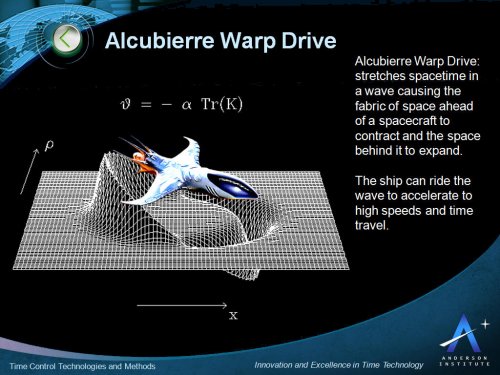 alcubierre-warp-drive-overview1.jpg157.9 KB · Views: 441
alcubierre-warp-drive-overview1.jpg157.9 KB · Views: 441 -
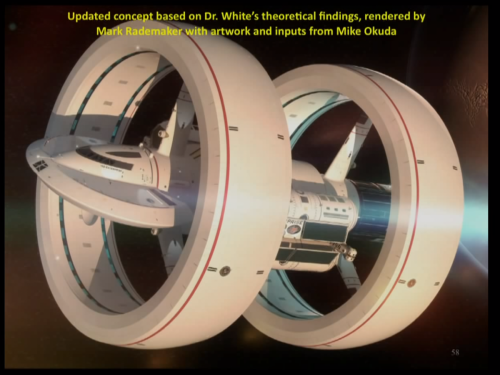 screen shot 2014-06-11 at 11.27.57 am.png1.1 MB · Views: 435
screen shot 2014-06-11 at 11.27.57 am.png1.1 MB · Views: 435 -
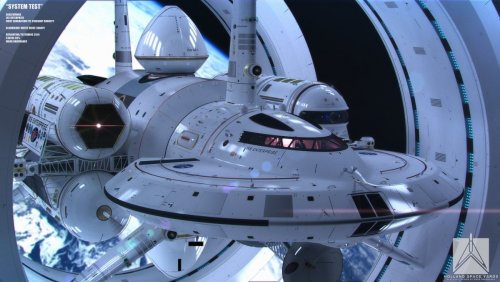 14038693038_ac55b54dee_o (1).jpg145.4 KB · Views: 410
14038693038_ac55b54dee_o (1).jpg145.4 KB · Views: 410 -
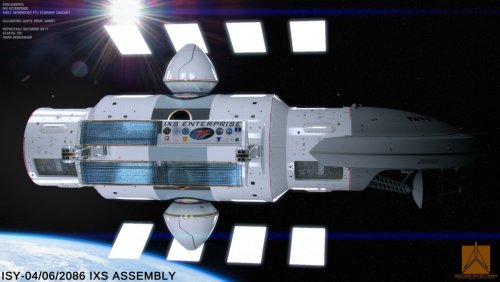 13793777355_95ba4f80f8_o.jpg107.3 KB · Views: 398
13793777355_95ba4f80f8_o.jpg107.3 KB · Views: 398 -
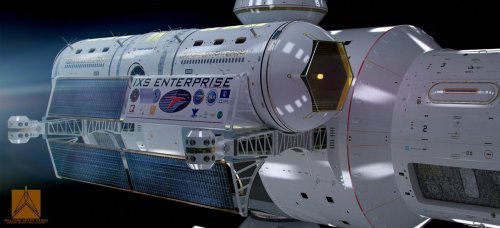 13943169112_14473e74b7_o.jpg114.8 KB · Views: 392
13943169112_14473e74b7_o.jpg114.8 KB · Views: 392 -
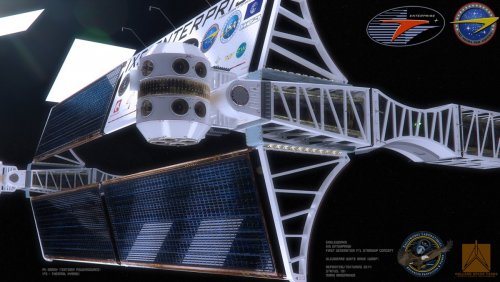 13793778425_c9228401fb_o.jpg162.6 KB · Views: 81
13793778425_c9228401fb_o.jpg162.6 KB · Views: 81
Re: Alcubbierre Warp Drive starship IXS Enterprise
View: http://youtu.be/-LmlqXVg7vc
View: http://youtu.be/J_ksq7cU-8M
"How NASA might build its very first warp drive"
by George Dvorsky
Filed to: Daily explainer
11/26/12 10:13am
Source:
http://io9.com/5963263/how-nasa-will-build-its-very-first-warp-drive
by George Dvorsky
Filed to: Daily explainer
11/26/12 10:13am
Source:
http://io9.com/5963263/how-nasa-will-build-its-very-first-warp-drive
A few months ago, physicist Harold White stunned the aeronautics world when he announced that he and his team at NASA had begun work on the development of a faster-than-light warp drive. His proposed design, an ingenious re-imagining of an Alcubierre Drive, may eventually result in an engine that can transport a spacecraft to the nearest star in a matter of weeks — and all without violating Einstein's law of relativity. We contacted White at NASA and asked him to explain how this real life warp drive could actually work.
The Alcubierre Drive
The idea came to White while he was considering a rather remarkable equation formulated by physicist Miguel Alcubierre. In his 1994 paper titled, "The Warp Drive: Hyper-Fast Travel Within General Relativity," Alcubierre suggested a mechanism by which space-time could be "warped" both in front of and behind a spacecraft.
How NASA might build its very first warp driveExpand
Michio Kaku dubbed Alcubierre's notion a "passport to the universe." It takes advantage of a quirk in the cosmological code that allows for the expansion and contraction of space-time, and could allow for hyper-fast travel between interstellar destinations. Essentially, the empty space behind a starship would be made to expand rapidly, pushing the craft in a forward direction — passengers would perceive it as movement despite the complete lack of acceleration.
White speculates that such a drive could result in "speeds" that could take a spacecraft to Alpha Centauri in a mere two weeks — even though the system is 4.3 light-years away.
How NASA might build its very first warp driveExpand
In terms of the engine's mechanics, a spheroid object would be placed between two regions of space-time (one expanding and one contracting). A "warp bubble" would then be generated that moves space-time around the object, effectively repositioning it — the end result being faster-than-light travel without the spheroid (or spacecraft) having to move with respect to its local frame of reference.
"Remember, nothing locally exceeds the speed of light, but space can expand and contract at any speed," White told io9. "However, space-time is really stiff, so to create the expansion and contraction effect in a useful manner in order for us to reach interstellar destinations in reasonable time periods would require a lot of energy."
And indeed, early assessments published in the ensuing scientific literature suggested horrific amounts of energy — basically equal to the mass-energy of the planet Jupiter (what is 1.9 × 1027 kilograms or 317 Earth masses). As a result, the idea was brushed aside as being far too impractical. Even though nature allowed for a warp drive, it looked like we would never be able to build one ourselves.
"However," said White, "based on the analysis I did the last 18 months, there may be hope." The key, says White, may be in altering the geometry of the warp drive itself.
A new design
In October of last year, White was preparing for a talk he was to give for the kickoff to the 100 Year Starship project in Orlando, Florida. As he was pulling together his overview on space warp, he performed a sensitivity analysis for the field equations, more out of curiosity than anything else.
How NASA might build its very first warp driveExpand
"My early results suggested I had discovered something that was in the math all along," he recalled. "I suddenly realized that if you made the thickness of the negative vacuum energy ring larger — like shifting from a belt shape to a donut shape — and oscillate the warp bubble, you can greatly reduce the energy required — perhaps making the idea plausible." White had adjusted the shape of Alcubierre's ring which surrounded the spheroid from something that was a flat halo to something that was thicker and curvier.
He presented the results of his Alcubierre Drive rethink a year later at the 100 Year Starship conference in Atlanta where he highlighted his new optimization approaches — a new design that could significantly reduce the amount of exotic matter required. And in fact, White says that the warp drive could be powered by a mass that's even less than that of the Voyager 1 spacecraft.
That's a significant change in calculations to say the least. The reduction in mass from a Jupiter-sized planet to an object that weighs a mere 1,600 pounds has completely reset White's sense of plausibility — and NASA's.
Hitting the lab
Theoretical plausibility is all fine and well, of course. What White needs now is a real-world proof-of-concept. So he's hit the lab and begun work on actual experiments.
"We're utilizing a modified Michelson-Morley interferometer — that allows us to measure microscopic perturbations in space time," he said. "In our case, we're attempting to make one of the legs of the interferometer appear to be a different length when we energize our test devices." White and his colleagues are trying to simulate the tweaked Alcubierre drive in miniature by using lasers to perturb space-time by one part in 10 million.
Of course, the interferometer isn't something that NASA would bolt onto a spaceship. Rather, it's part of a larger scientific pursuit.
"Our initial test device is implementing a ring of large potential energy — what we observe as blue shifted relative to the lab frame — by utilizing a ring of ceramic capacitors that are charged to tens of thousands of volts," he told us. "We will increase the fidelity of our test devices and continue to enhance the sensitivity of the warp field interferometer — eventually using devices to directly generate negative vacuum energy."
He points out that Casimir cavities, physical forces that arise from a quantized field, may represent a viable approach.
And it's through these experiments, hopes White, that NASA can go from the theoretical to the practical.
Waiting for that "Chicago Pile" moment
Given just how fantastic this all appears, we asked White if he truly thinks a warp-generating spacecraft might someday be constructed.
"Mathematically, the field equations predict that this is possible, but it remains to be seen if we could ever reduce this to practice."
How NASA might build its very first warp driveExpand
What White is waiting for is existence of proof — what he's calling a "Chicago Pile" moment — a reference to a great practical example.
"In late 1942, humanity activated the first nuclear reactor in Chicago generating a whopping half Watt — not enough to power a light bulb," he said. "However, just under one year later, we activated a ~4MW reactor which is enough to power a small town. Existence proof is important."
His cautious approach notwithstanding, White did admit that a real-world warp drive could create some fascinating possibilities for space travel — and would certainly reset our sense of the vastness of the cosmos.
"This loophole in general relativity would allow us to go places really fast as measured by both Earth observers, and observers on the ship — trips measured in weeks or months as opposed to decades and centuries," he said.
But for now, pursuit of this idea is very much in science mode. "I'm not ready to discuss much beyond the math and very controlled modest approaches in the lab," he said.
Which makes complete sense to us, as well. But thanks to these preliminary efforts, White has already done much to instill a renewed sense of hope and excitement over the possibilities. Faster-than-light travel may await us yet.
"Mark Rademaker: Designing a warp drive space ship for NASA"
For some years now, NASA's Harold White has been working on the possibility of a warp drive engine. This is the concept ship that might be powered by that engine.
by Michelle Starr
June 11, 2014 11:05 PM PDT
Source:
http://www.cnet.com/news/mark-rademaker-designing-a-warp-drive-space-ship-for-nasa/
For some years now, NASA's Harold White has been working on the possibility of a warp drive engine. This is the concept ship that might be powered by that engine.
by Michelle Starr
June 11, 2014 11:05 PM PDT
Source:
http://www.cnet.com/news/mark-rademaker-designing-a-warp-drive-space-ship-for-nasa/
Warp engines -- technology that would allow space travel faster than the speed of light -- are still very much the stuff of science fiction. Science fiction, however, enters the realm of science fact through careful research, development and experimentation. This is where Dr Harold White comes in. For a few years now, he has been working on the idea of a warp drive for NASA -- based on the Alcubierre drive which manipulates time and space to create propulsion.
Dutch Mark Rademaker is not an engineer. Nor is he a physicist. He is a digital artist -- one who has worked within the Star Trek canon, and therefore was perfectly placed to be recruited by Dr White and Star Trek graphic designer Michael Okuda after they saw his rendition of the XCV-330 designed by Matt Jefferies -- the original designer of the Starship Enterprise. Rademaker's brief? To design the concept for a ship that could conceivably be powered by the Alcubierre drive -- a ship called the IXS Enterprise.
"Trek ships can be very particular, they have a set of design rules created by Gene Roddenberry. Deviation is possible, but it's best to follow them unless you have a very good 'Treknological' reason to do things differently," Rademaker explained to CNET.
"My own designs for the most part followed these guidelines. I do put research in things like era, events in the Trek timeline, plausible registry numbers and specifications of a ship. I put about three months of research in the XCV-330 Ringship that Matt Jefferies sketched in the 1960s. I was asked to convert that sketch/blueprint as a 3D CGI model, I wanted it to look spot on."
Dr Harold White explains the warp drive at SpaceVision 2013.
It was Jefferies' Ringship that was to form the basis of the concept for NASA, with the idea being that the rings produce the space/time bubble that allows the ship to move forward through the warp. Although the ship was just a concept, there were some challenges not present in designing purely for the fictional realm.
"Maths and physics are totally not my cup of tea, the math involved here is way, way over my head. Dr White was very good at explaining what I needed to know and what I would understand," Rademaker said. "Mike Okuda gave a lot of feedback at the start of the project and he designed the IXS Enterprise insignia. White gave pointers about ring thickness, outer curvature and how we could fill the inside of the rings, without wasting too much valuable space. When we had the basic shape pinned, I could freely add details and features, with communication about my progress each couple of days."
The ship looks as complex as anything seen in science fiction, and this in itself posed its own set of challenges. Everything on the ship, Rademaker said, had to have a function -- he couldn't just add details that he thought looked cool and add an explanation later. And there were a lot of parts.
"To keep track of 2500+ parts in the assembly," Rademaker said, when asked what the biggest challenge actually was. "No matter how well I planned this, it's a lot of parts to handle. My workstation had trouble with the rather heavy model, at a certain point I needed to upgrade to a faster/more capable PC."
It certainly looks the part -- although the project is still in very, very early days -- still in its speculative stage, according to the official NASA website. But the idea at this point is not to design a fully functional ship.
"We designed this mainly to interest people in space travel; the research might or might not lead to a breakthrough in FTL propulsion, but always will return valuable data. I think it's decades and many many evolutions away from a working prototype. To see it fly in this exact form is highly unlikely," Rademaker said.
That's a shame, for sure, but if the job of the IXS Enterprise is to spark imaginations, well, it's certainly doing that in spades
"IXS Enterprise"
by Mark Rademaker
June 21, 2013
Source:
http://mark-rademaker.blogspot.com/2013/06/ixs-enterprise.html
by Mark Rademaker
June 21, 2013
Source:
http://mark-rademaker.blogspot.com/2013/06/ixs-enterprise.html
Many months have passed since I last posted an update. While my intention was to share anything the project I was working on was too important/too demanding to write an article during the "construction".
The IXS Enterprise, a very early concept of the first real warpship. When I got invited by Dr. Harold "Sonny" White and Mike Okuda, I was absolutely stunned. Did that just really happen? A person from NASA contacted me to do artwork for them? Yes it did! After seeing my rendition of Matt Jefferies "Ring Ship", Dr. White thought that this would be a good starting point for a near future "Ring Ship". At least from a STEM perspective. Because that is the main goal: to get a warpship concept out there that would inspire young people to choose a career in STEM.
However the XCV-330 needed some adaptions to fit to the latest warp theory. After making some adjustments, we quickly realized it would be better to start from scratch. I started to draw some logical (in my mind) shapes, Mike Okuda joined in to give some extremely helpful technical advice. He also concepted a 2D version that made excellent use of the space within the 2 rings. I tried to put as much of it into the IXS without loosing the motivational perspective. This perspective is also the reason why I made some (in reality) rather unpractical design choices. For example the windows in the cockpit, (a small homage to the spaceshuttle) the ship would be fully flown by wire/computer, but to have an outlook into space and to give the ship a face was very important to me. This was the main priority on my wishlist.
For a few weeks we kept tweaking and modifying the rough layouts, and when we finally concluded what direction to go, I secluded myself and started to work out the shapes and think over the details. Meanwhile Doug Drexler joined in to get this ship on the SOTL 2014 calendar. That was even better, I never walked the line between science and SCI-FI this close. (Or reality/fantasy.)
Time passed and I kept on modeling. Because the ship is even smaller than the XCV-330 I wanted to give it a very physical appeance. Very little textures and a lot of real surface detail. This did not really speed up the modeling, but in the end did work out quite well. The smallest edge blend on this ship is 2mm, the paneling and even the slots to keep the paneling in place are all modeled. If a tube flows into something, there is a slot where this tube will go into. No "hull stucking" so to speak. Hardly visible, but in my mind very satisfying.
Deadline for SOTL approached and I had to move on to make this happen. Because of the rather fat rings and the short/stubby length, it was very difficult to get a wide shot that would show it all. After a lot of consideration with Doug we finally got a decent angle. When I finished the SOTL entry (this March) I decided to take a quick brake. After a week I got back into it, and started to convert the entire ship to mesh and to name all the parts. (Over 2000 of them) Also I added more details to the underside of the ship, that was not visible on the calendar shot. I'm currently working on the last phase: texturing the nomenclature/signs/arrows/labels. This will take some time to complete. The result will be the best model I have done so far, the most manageable despite it's 80 million+ polygons and most importaly one that might inspire the next generation to choose for space and science. Lets face it, there is an entire endless Universe waiting out there to be explored. Why are we still here?
- Mark
Avimimus
ACCESS: Top Secret
- Joined
- 15 December 2007
- Messages
- 2,429
- Reaction score
- 911
First half science.
Second half fiction.
There is a long way to go between 'we aren't sure it isn't impossible' to hardware ...and certainly to finding a place that is halfway acceptable to be worth the trip. If there was ever a competition between artist conceptions' that are simply PR gestures...
Second half fiction.
There is a long way to go between 'we aren't sure it isn't impossible' to hardware ...and certainly to finding a place that is halfway acceptable to be worth the trip. If there was ever a competition between artist conceptions' that are simply PR gestures...
Avimimus said:First half science.
Second half fiction.
There is a long way to go between 'we aren't sure it isn't impossible' to hardware ...and certainly to finding a place that is halfway acceptable to be worth the trip. If there was ever a competition between artist conceptions' that are simply PR gestures...
Maybe I should have posted this in the Bar. However since Dr. Harold White is on NASA's payroll, I thought that this topic should be posted in "Theoretical and Speculative Projects." Perhaps credibility suffers when a NASA scientist contacts a graphic artist best known for his participation as a designer for several Star Trek television series and feature films. This graphic artist then contacts a creator of Star Trek fan ships to render the concept who then attempts to insert the highly speculative design into Star Trek fanon.
- Joined
- 9 October 2009
- Messages
- 21,979
- Reaction score
- 13,647
The two Voyager probes have taken 35 years to reach the outer border of the Solar System, where the interstellar space begins.
In long-term trips, space probes are propelled by ion engines, using charged particles which were expelled to create thrust. They currently are not very powerful.
To travel through the space accelerating at many thousands of times the standard gravity, it would be necessary to increase its power by a million times to obtain the type of engine that science fiction series call 'sublight drive'.
But there are speed limits also in space, as it is not empty at all. Orbiting around the Sun, on the same plane as the planets, there are billions of invisible rocks of all sizes, from a grain of dust to a city, a true cosmic minefield.
Travelling at minimal orbital velocity, the impact of a grain of sand is equivalent to that of the 7.62 × 51 mm projectile fired by a sniper. If it is the size of a pea, it may cause the same damage as an infantry hand grenade and, if it has the diameter of an orange, its destruction power equals that of a gunnery shell of 105 mm.
The situation worsens exponentially at higher speeds. Traveling at 1/10 the speed of light the impact of a simple hydrogen atom equals a one Hiroshima.
Increasing the resilience of the spaceship hull would not solve this problem, which is why Science Fiction writers created the concept of force field, an invisible wall of resistance, commonly a protective electromagnetic shield against radiation and material impacts.
Such a technological marvel exists only in theory, but we will never reach the stars without it, nor will ET be able to reach us. We know that the answer has always been within a magnet, but it is necessary to find a way to separate the poles.
Even with a force field it would be preferable to avoid the large concentration of matter existing in the plane of the Solar System and ascend on a perpendicular trajectory to quickly reach the interstellar space.
Battleships of the Second World War might have withstood the impact of an iceberg, but their captains preferred to use radar to avoid them.
In long-term trips, space probes are propelled by ion engines, using charged particles which were expelled to create thrust. They currently are not very powerful.
To travel through the space accelerating at many thousands of times the standard gravity, it would be necessary to increase its power by a million times to obtain the type of engine that science fiction series call 'sublight drive'.
But there are speed limits also in space, as it is not empty at all. Orbiting around the Sun, on the same plane as the planets, there are billions of invisible rocks of all sizes, from a grain of dust to a city, a true cosmic minefield.
Travelling at minimal orbital velocity, the impact of a grain of sand is equivalent to that of the 7.62 × 51 mm projectile fired by a sniper. If it is the size of a pea, it may cause the same damage as an infantry hand grenade and, if it has the diameter of an orange, its destruction power equals that of a gunnery shell of 105 mm.
The situation worsens exponentially at higher speeds. Traveling at 1/10 the speed of light the impact of a simple hydrogen atom equals a one Hiroshima.
Increasing the resilience of the spaceship hull would not solve this problem, which is why Science Fiction writers created the concept of force field, an invisible wall of resistance, commonly a protective electromagnetic shield against radiation and material impacts.
Such a technological marvel exists only in theory, but we will never reach the stars without it, nor will ET be able to reach us. We know that the answer has always been within a magnet, but it is necessary to find a way to separate the poles.
Even with a force field it would be preferable to avoid the large concentration of matter existing in the plane of the Solar System and ascend on a perpendicular trajectory to quickly reach the interstellar space.
Battleships of the Second World War might have withstood the impact of an iceberg, but their captains preferred to use radar to avoid them.
Ummm... a hydrogen atom has a mass of 1.6735 x 10^-27 kilograms. At 1/10 light speed, 299,792 meters/sec, kinetic energy = 1/2 * M*V^2 = 1/2 * 1.6735 x 10^-27 * 299,792 * 299,792 = 7.52x10^-17 Joules. One Hiroshima = ~20 kilotons = 20*4.184e+12 = 8.368x10^13 J. You'd need 1.1x10^30 hydrogen atoms at 1/10 c for a single Hiroshima... about 1.86 metric tons.The situation worsens exponentially at higher speeds. Traveling at 1/10 the speed of light the impact of a simple hydrogen atom equals a one Hiroshima.
To get one Hiroshima out of a single Hydrogen atom, you need to be going at *high* relativistic speeds... 99.9999+% light speed. Consider that proton accelerators routinely get bunches of protons moving at nearly arbitrarily close to c speeds, and they don't produce anything like an atom bomb worth of bang.
- Joined
- 9 October 2009
- Messages
- 21,979
- Reaction score
- 13,647
Yet sir, not yet.Consider that proton accelerators routinely get bunches of protons moving at nearly arbitrarily close to c speeds, and they don't produce anything like an atom bomb worth of bang.
OK, 1/10 HiroshimaUmmm... a hydrogen atom has a mass of 1.6735 x 10^-27 kilograms. At 1/10 light speed, 299,792 meters/sec, kinetic energy = 1/2 * M*V^2 = 1/2 * 1.6735 x 10^-27 * 299,792 * 299,792 = 7.52x10^-17 Joules. One Hiroshima = ~20 kilotons = 20*4.184e+12 = 8.368x10^13 J. You'd need 1.1x10^30 hydrogen atoms at 1/10 c for a single Hiroshima... about 1.86 metric tons.The situation worsens exponentially at higher speeds. Traveling at 1/10 the speed of light the impact of a simple hydrogen atom equals a one Hiroshima.
To get one Hiroshima out of a single Hydrogen atom, you need to be going at *high* relativistic speeds... 99.9999+% light speed. Consider that proton accelerators routinely get bunches of protons moving at nearly arbitrarily close to c speeds, and they don't produce anything like an atom bomb worth of bang.
- Joined
- 15 July 2007
- Messages
- 4,889
- Reaction score
- 4,554
Strictly the creation of a bubble of spacetime, means only the connection to the rest of the universe has to move.
As for what such a mechanism looks like that could generate such a bubble......
The risk of course is that your bubble might separate from the rest of spacetime and float off into hyperspace. With no guarantee or can connect to any universe, let alone the one it left.
A double nightmare, since not only the ship creating it is now unconnected to the universe, but the amount of matter and energy in the universe has been changed. With potentially deep consequences for the long term.
As for what such a mechanism looks like that could generate such a bubble......
The risk of course is that your bubble might separate from the rest of spacetime and float off into hyperspace. With no guarantee or can connect to any universe, let alone the one it left.
A double nightmare, since not only the ship creating it is now unconnected to the universe, but the amount of matter and energy in the universe has been changed. With potentially deep consequences for the long term.
Yet sir, not yet.Consider that proton accelerators routinely get bunches of protons moving at nearly arbitrarily close to c speeds, and they don't produce anything like an atom bomb worth of bang.
As with pretty much anything else, you don't get out more than you put in. To get a nukes worth of reaction from a proton accelerator, you need to put at least a nukes worth into powering the thing.
Nik
ACCESS: Top Secret
- Joined
- 15 July 2009
- Messages
- 1,269
- Reaction score
- 1,063
I'm reminded of the AC Clarke tale where, due to a minor math error, fast (subluminal) interstellar travel was nearly missed. The ship did require a thick frontal shield of ice, literally a DIY comet. So, when that ate something at far end of distribution curve, they had to stop off at a slow-boat settled planet and do some ice sculpting. Seemed a bit contrived...
IIRC, the 'Daedalus Final Report' fretted about inter-stellar and in-system mascons but, without digging it out of storage, I can't remember if they planned to use 'chaff' and 'talc' as 'path-sweepers' for the cruise phase. Certainly for the fly-through probes...
{ Off-topic, but one of our tabby cats has just strolled across keyboard without deranging my text: Is this a first ?? }
IIRC, the 'Daedalus Final Report' fretted about inter-stellar and in-system mascons but, without digging it out of storage, I can't remember if they planned to use 'chaff' and 'talc' as 'path-sweepers' for the cruise phase. Certainly for the fly-through probes...
{ Off-topic, but one of our tabby cats has just strolled across keyboard without deranging my text: Is this a first ?? }
- Joined
- 9 October 2009
- Messages
- 21,979
- Reaction score
- 13,647
Miracles do still happen...{ Off-topic, but one of our tabby cats has just strolled across keyboard without deranging my text: Is this a first ?? }
Macbeth, "What, sir, not yet at rest?"Yet sir, not yet.Consider that proton accelerators routinely get bunches of protons moving at nearly arbitrarily close to c speeds, and they don't produce anything like an atom bomb worth of bang.
- Joined
- 21 January 2015
- Messages
- 12,166
- Reaction score
- 16,389
Here’s the latest paper on the Alcubierre drive showing it is an allowable proposal theoretically.
The Alcubierre warp drive is an exotic solution in general relativity. It allows for superluminal travel at the cost of enormous amounts of matter with negative mass density. For this reason, the Alcubierre warp drive has been widely considered unphysical. In this study, we develop a model of a general warp drive spacetime in classical relativity that encloses all existing warp drive definitions and allows for new metrics without the most serious issues present in the Alcubierre solution. We present the first general model for subliminal positive-energy, spherically symmetric warp drives; construct superluminal warp-drive solutions which satisfy quantum inequalities; provide optimizations for the Alcubierre metric that decrease the negative energy requirements by two orders of magnitude; and introduce a warp drive spacetime in which space capacity and the rate of time can be chosen in a controlled manner. Conceptually, we demonstrate that any warp drive, including the Alcubierre drive, is a shell of regular or exotic material moving inertially with a certain velocity. Therefore, any warp drive requires propulsion. We show that a class of subluminal, spherically symmetric warp drive spacetimes, at least in principle, can be constructed based on the physical principles known to humanity today.[/I ]
Related article.
Full paper
The Alcubierre warp drive is an exotic solution in general relativity. It allows for superluminal travel at the cost of enormous amounts of matter with negative mass density. For this reason, the Alcubierre warp drive has been widely considered unphysical. In this study, we develop a model of a general warp drive spacetime in classical relativity that encloses all existing warp drive definitions and allows for new metrics without the most serious issues present in the Alcubierre solution. We present the first general model for subliminal positive-energy, spherically symmetric warp drives; construct superluminal warp-drive solutions which satisfy quantum inequalities; provide optimizations for the Alcubierre metric that decrease the negative energy requirements by two orders of magnitude; and introduce a warp drive spacetime in which space capacity and the rate of time can be chosen in a controlled manner. Conceptually, we demonstrate that any warp drive, including the Alcubierre drive, is a shell of regular or exotic material moving inertially with a certain velocity. Therefore, any warp drive requires propulsion. We show that a class of subluminal, spherically symmetric warp drive spacetimes, at least in principle, can be constructed based on the physical principles known to humanity today.[/I ]
Related article.
Full paper
Last edited:
Dilandu
I'm dissatisfied, which means, I exist.
Here’s the latest paper on the Alcubierre drive showing it is an allowable proposal theoretically.
Well, it's interesting. Firstly, they specifically pointed that it's a sublight drive; i.e. you could not move faster-than-light with it, but could move pretty close to light speed.
Secondly, they seems to find the way to avoid the problematic negative matter at all. They are trying to invent warp drive that could work on "usual", "positive" gravity.
- Joined
- 21 January 2015
- Messages
- 12,166
- Reaction score
- 16,389
Sometimes scientists get stuck in a problem and have no choice but to use their creativity to imagine concepts that justify their theories, although they call it theoretical physics that sounds better.
In 1869 Dmitri Mendeleev had the 'inspiration' of creating a farsighted version of the periodic table of elements leaving gaps for some elements still unknown but of predictable properties. He was lucky and when they were discovered, between 1874 and 1886, he became a hero.
In 1930 Wolfgang Pauli 'invented' a particle called Neutrino as a desperate remedy to explain an incomprehensible phenomenon named Beta disintegration, knowing that perhaps its existence could never be experimentally proven. But he got lucky and the Neutrino was officially discovered in 1956.
In 1984 a physicist of the Berkeley University named Richard Mueller imagined the existence of Nemesis, a dark star orbiting at 16,000,000,000 kilometers around the Sun, to explain certain orbital alterations experienced by Uranus and Neptune. But so far, he has not had any luck.
At the beginning of the twentieth century, science became stuck again because the established paradigm of the Standard Model of Particle Physics was unable to explain the Dark Matter, the Dark Energy, the Gravitational Quantum State, and the Cosmological Constant phenomena. The theoretical physicists have been formulating models on the String Theory that are impossible to demonstrate because this would require amounts of energy that exceed the available technology.
Science or faith?
In 2018 Sabine Hossenfelder of the Frankfurt Institute for Advanced Studies, published the book ‘Lost in Math: How Beauty Leads Physics Astray’. Sabine argues that the theoretical physicists have lost the North. We have not seen a major breakthrough in the foundations of physics for more than four decades. Paucity of major advances in fundamental physics is partly due to an overemphasis on aesthetic criteria such as symmetry and mathematical beauty, in the face of their inability to overcome the new challenges posed to science.
In 1453, while the Turks shelled the walls of Constantinople with 1,054 mm heavy artillery, Byzantine theologians were debating the sex of angels instead of defending the fortress. They ended badly.
Science Fiction writers have 'solved' the issue by imagining a subspace driver using Faster Than Light (FTL) technology, something that violates Einstein's established paradigm. Everyone knows this is impossible, but my neural network by defect tells me it will finally be built by someone who did not know it... or we will stay here until the Sun freezes!
The FTL hypothesis starts out from the assumption that technological progress has no upper limit. But we must consider the possibility that the human mind be incapable of solving the problem. Nor can we lift a ton of weight, fly, run at 100 mph, breath underwater, or see Uranus, the heat, or the bacteria... but we have found a way to build machines that do it for us.
Maybe Artificial Intelligence will uncover the secrets of the FTL.
Interstellar travel will only stop being a utopia when the theoretical physicists became desperate to consider all the time lost in the face of a barrier that had been existing only in their own minds.
If they are unable to develop a new Physics, they will end up being replaced by an Artificial Intelligence that does not respect the established paradigm.
In 1869 Dmitri Mendeleev had the 'inspiration' of creating a farsighted version of the periodic table of elements leaving gaps for some elements still unknown but of predictable properties. He was lucky and when they were discovered, between 1874 and 1886, he became a hero.
In 1930 Wolfgang Pauli 'invented' a particle called Neutrino as a desperate remedy to explain an incomprehensible phenomenon named Beta disintegration, knowing that perhaps its existence could never be experimentally proven. But he got lucky and the Neutrino was officially discovered in 1956.
In 1984 a physicist of the Berkeley University named Richard Mueller imagined the existence of Nemesis, a dark star orbiting at 16,000,000,000 kilometers around the Sun, to explain certain orbital alterations experienced by Uranus and Neptune. But so far, he has not had any luck.
At the beginning of the twentieth century, science became stuck again because the established paradigm of the Standard Model of Particle Physics was unable to explain the Dark Matter, the Dark Energy, the Gravitational Quantum State, and the Cosmological Constant phenomena. The theoretical physicists have been formulating models on the String Theory that are impossible to demonstrate because this would require amounts of energy that exceed the available technology.
Science or faith?
In 2018 Sabine Hossenfelder of the Frankfurt Institute for Advanced Studies, published the book ‘Lost in Math: How Beauty Leads Physics Astray’. Sabine argues that the theoretical physicists have lost the North. We have not seen a major breakthrough in the foundations of physics for more than four decades. Paucity of major advances in fundamental physics is partly due to an overemphasis on aesthetic criteria such as symmetry and mathematical beauty, in the face of their inability to overcome the new challenges posed to science.
In 1453, while the Turks shelled the walls of Constantinople with 1,054 mm heavy artillery, Byzantine theologians were debating the sex of angels instead of defending the fortress. They ended badly.
Science Fiction writers have 'solved' the issue by imagining a subspace driver using Faster Than Light (FTL) technology, something that violates Einstein's established paradigm. Everyone knows this is impossible, but my neural network by defect tells me it will finally be built by someone who did not know it... or we will stay here until the Sun freezes!
The FTL hypothesis starts out from the assumption that technological progress has no upper limit. But we must consider the possibility that the human mind be incapable of solving the problem. Nor can we lift a ton of weight, fly, run at 100 mph, breath underwater, or see Uranus, the heat, or the bacteria... but we have found a way to build machines that do it for us.
Maybe Artificial Intelligence will uncover the secrets of the FTL.
Interstellar travel will only stop being a utopia when the theoretical physicists became desperate to consider all the time lost in the face of a barrier that had been existing only in their own minds.
If they are unable to develop a new Physics, they will end up being replaced by an Artificial Intelligence that does not respect the established paradigm.
Attachments
Rhinocrates
ACCESS: Top Secret
- Joined
- 26 September 2006
- Messages
- 3,058
- Reaction score
- 7,805
IIRC, it was to deploy a dust cloud ahead, maintained by a robot. Perhaps held together by electrostatic charge?I'm reminded of the AC Clarke tale where, due to a minor math error, fast (subluminal) interstellar travel was nearly missed. The ship did require a thick frontal shield of ice, literally a DIY comet. So, when that ate something at far end of distribution curve, they had to stop off at a slow-boat settled planet and do some ice sculpting. Seemed a bit contrived...
IIRC, the 'Daedalus Final Report' fretted about inter-stellar and in-system mascons but, without digging it out of storage, I can't remember if they planned to use 'chaff' and 'talc' as 'path-sweepers' for the cruise phase. Certainly for the fly-through probes...
{ Off-topic, but one of our tabby cats has just strolled across keyboard without deranging my text: Is this a first ?? }
Rhinocrates
ACCESS: Top Secret
- Joined
- 26 September 2006
- Messages
- 3,058
- Reaction score
- 7,805
Currently paywalled, I'll have to wait for a paper issue to see what names to look up: https://www.newscientist.com/articl...doesnt-break-the-laws-of-physics-is-possible/
jeffb
ACCESS: Top Secret
- Joined
- 7 October 2012
- Messages
- 1,283
- Reaction score
- 1,946
IIRC, it was to deploy a dust cloud ahead, maintained by a robot. Perhaps held together by electrostatic charge?I'm reminded of the AC Clarke tale where, due to a minor math error, fast (subluminal) interstellar travel was nearly missed. The ship did require a thick frontal shield of ice, literally a DIY comet. So, when that ate something at far end of distribution curve, they had to stop off at a slow-boat settled planet and do some ice sculpting. Seemed a bit contrived...
IIRC, the 'Daedalus Final Report' fretted about inter-stellar and in-system mascons but, without digging it out of storage, I can't remember if they planned to use 'chaff' and 'talc' as 'path-sweepers' for the cruise phase. Certainly for the fly-through probes...
{ Off-topic, but one of our tabby cats has just strolled across keyboard without deranging my text: Is this a first ?? }
There's a paper proposing another Alcubierre like space-time metric that I have around here (somewhere) that talked about creating a warp bubble that was smaller on the outside than the inside. So small that it was effectively microscopic, avoiding (largely) the issue of colliding with matter in the path of the craft.
Ha! Found it. Don't ask me about the math though! I'm pretty sure this one's reliant on vast gobs of negative energy as well but, hey, fun idea!
Attachments
Dilandu
I'm dissatisfied, which means, I exist.
TARDIS?Alcubierre like space-time metric that I have around here (somewhere) that talked about creating a warp bubble that was smaller on the outside than the inside
jeffb
ACCESS: Top Secret
- Joined
- 7 October 2012
- Messages
- 1,283
- Reaction score
- 1,946
No sorry, I mis-remembered. It's a metric that narrows to microscopic dimensions ahead (and I think behind) of the main passenger/ship carrying section of the bubble. Authors believe that fixes the problem of running into interstellar debris.
- Joined
- 21 January 2015
- Messages
- 12,166
- Reaction score
- 16,389
Is the Warp Drive Possible? With Alexey Bobrick and Gianni Martire:
View: https://youtu.be/vclfqT5oOyY
FighterJock
ACCESS: Above Top Secret
- Joined
- 29 October 2007
- Messages
- 5,613
- Reaction score
- 5,946
Is the Warp Drive Possible? With Alexey Bobrick and Gianni Martire:
View: https://youtu.be/vclfqT5oOyY
I have been following the Alcubierre warp drive theory since the beginning and find the whole process fascinating, given the fact that there seems to be nothing in the current laws of physics that says that such a drive is impossible.
Nik
ACCESS: Top Secret
- Joined
- 15 July 2009
- Messages
- 1,269
- Reaction score
- 1,063
snark:
"Nothing that efficient fusion and a couple of centuries of engineering progress can't solve..."
/
Seriously, I've seen 'Plate Tectonics' up-end Geology, 'Big Bang' & CMB up-end Cosmology, Quarks up-end sub-atomic Physics, neutrinos detected and found to have non-zero mass, Higgs Boson(s) spotted etc etc. I've just assembled a 16-core, 32 GB x64 PC as a network render box to augment my CAD-Tower-- As significantly cheaper and more future-proof than significantly upgrading either of Tower's GPU cards. Heck of advance on the 6502, 48 kB x8 Apple ][+ I used for 3D Astronomy...
Currently, the big head-scratchers seem to be Muons, 'Dark Matter', 'Dark Energy' and how-the-heck to square gravity with quantum physics...
IIRC, Muons, sorta 'heavy electrons', are not quite behaving as extrapolated from electron models, which are good to yay-many decimal places. Either there's 'new physics', or just some subtle modifier required. The way self-interacting 'relativistic orbital effects' mean gold (Au) looks golden rather than silvery (Ag), and lead (Pb) is weird...
One 'joker' could be that much 'Dark Matter' is an illusion caused by gravitational energy self-focussing into plane of galactic disks. Bit like a mirage. My understanding is that gravity's c-limit would mean that galactic fringes still 'see' former disk planes for a long, long time after parent spirals collide and merge to 'elliptical'...
Sorry, have lost Arxiv reference...
Upside of sorts is that 'Trumpet' EM Drive turned out to be thermal effects, just like the infamous Pioneer Anomaly. But sorta sad...
"Nothing that efficient fusion and a couple of centuries of engineering progress can't solve..."
/
Seriously, I've seen 'Plate Tectonics' up-end Geology, 'Big Bang' & CMB up-end Cosmology, Quarks up-end sub-atomic Physics, neutrinos detected and found to have non-zero mass, Higgs Boson(s) spotted etc etc. I've just assembled a 16-core, 32 GB x64 PC as a network render box to augment my CAD-Tower-- As significantly cheaper and more future-proof than significantly upgrading either of Tower's GPU cards. Heck of advance on the 6502, 48 kB x8 Apple ][+ I used for 3D Astronomy...
Currently, the big head-scratchers seem to be Muons, 'Dark Matter', 'Dark Energy' and how-the-heck to square gravity with quantum physics...
IIRC, Muons, sorta 'heavy electrons', are not quite behaving as extrapolated from electron models, which are good to yay-many decimal places. Either there's 'new physics', or just some subtle modifier required. The way self-interacting 'relativistic orbital effects' mean gold (Au) looks golden rather than silvery (Ag), and lead (Pb) is weird...
One 'joker' could be that much 'Dark Matter' is an illusion caused by gravitational energy self-focussing into plane of galactic disks. Bit like a mirage. My understanding is that gravity's c-limit would mean that galactic fringes still 'see' former disk planes for a long, long time after parent spirals collide and merge to 'elliptical'...
Sorry, have lost Arxiv reference...
Upside of sorts is that 'Trumpet' EM Drive turned out to be thermal effects, just like the infamous Pioneer Anomaly. But sorta sad...
Dilandu
I'm dissatisfied, which means, I exist.
I have been following the Alcubierre warp drive theory since the beginning and find the whole process fascinating, given the fact that there seems to be nothing in the current laws of physics that says that such a drive is impossible.
Well, at least nothing says that slower-than-light warp drive is impossible. Faster-than-light warp drives tend to clash with causality and relativity. But even slower-than-light warp drive is quite an advancement: it would allow to move very close to speol without all those Tsiolkovsky equation headache, and 4-5 years to nearest star is pretty tolerable delay.
- Joined
- 4 July 2010
- Messages
- 2,516
- Reaction score
- 3,100
An interesting blog post diving into the recent work of Dr. Erik Lentz, who seems to still be in the "FTL is possible" camp.
- Joined
- 21 January 2015
- Messages
- 12,166
- Reaction score
- 16,389
Round up of the latest thinking on the topic.

 www.scientificamerican.com
www.scientificamerican.com

Star Trek's Warp Drive Leads to New Physics
Researchers are taking a closer look at this science-fiction staple—and bringing the idea a little closer to reality
aonestudio
I really should change my personal text
- Joined
- 11 March 2018
- Messages
- 2,967
- Reaction score
- 7,498
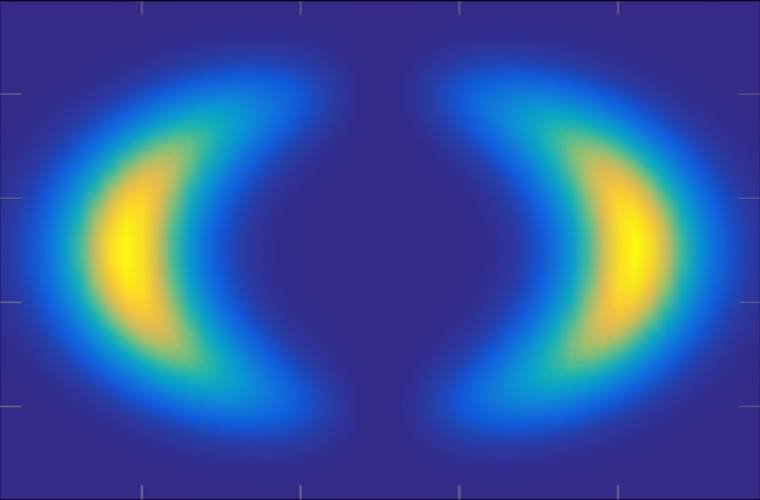
DARPA Funded Researchers Accidentally Discover The World's First Warp Bubble
Warp drive pioneer Dr. Harold G “Sonny” White has reported research results that he believes could theoretically manifest a warp bubble under laboratory conditions.
I wish I could belive that. There was an FTL signal claim that was chalked up to be an artifact due to length of a wire. If this is real-it shouldn't have been reported. I've had the football yanked away from me too many times.
- Joined
- 13 August 2007
- Messages
- 8,465
- Reaction score
- 11,073
here some papers about Chris Van Den Broeck idea
on Variable Space time bubble for Warp drive, outside is smaller that inside bubble.
using less energy to maintain that bubble during flight.
One of side effect is that Spaceship nearly not observable do small size during flight
But navigation is hell of a thing with reduce observed horizons at FTL speed
 arxiv.org
arxiv.org
on Variable Space time bubble for Warp drive, outside is smaller that inside bubble.
using less energy to maintain that bubble during flight.
One of side effect is that Spaceship nearly not observable do small size during flight
But navigation is hell of a thing with reduce observed horizons at FTL speed
A `warp drive' with more reasonable total energy requirements
I show how a minor modification of the Alcubierre geometry can dramatically improve the total energy requirements for a `warp bubble' that can be used to transport macroscopic objects. A spacetime is presented for which the total negative mass needed is of the order of a few solar masses...
altvw99
John G. Cramer Analog Column Alternate View 99 What We Don't Understand
www.npl.washington.edu
- Joined
- 21 January 2015
- Messages
- 12,166
- Reaction score
- 16,389
Look to 08:00 in this video:
View: https://youtu.be/HM_13s781cY
Sonny White's paper on this: Worldline numerics applied to custom Casimir geometry generates unanticipated intersection with Alcubierre warp metric
Sonny White's paper on this: Worldline numerics applied to custom Casimir geometry generates unanticipated intersection with Alcubierre warp metric
While conducting analysis related to a DARPA-funded project to evaluate possible structure of the energy density present in a Casimir cavity as predicted by the dynamic vacuum model, a micro/nano-scale structure has been discovered that predicts negative energy density distribution that closely matches requirements for the Alcubierre metric. The simplest notional geometry being analyzed as part of the DARPA-funded work consists of a standard parallel plate Casimir cavity equipped with pillars arrayed along the cavity mid-plane with the purpose of detecting a transient electric field arising from vacuum polarization conjectured to occur along the midplane of the cavity. An analytic technique called worldline numerics was adapted to numerically assess vacuum response to the custom Casimir cavity, and these numerical analysis results were observed to be qualitatively quite similar to a two-dimensional representation of energy density requirements for the Alcubierre warp metric. Subsequently, a toy model consisting of a 1 m diameter sphere centrally located in a 4 m diameter cylinder was analyzed to show a three-dimensional Casimir energy density that correlates well with the Alcubierre warp metric requirements. This qualitative correlation would suggest that chip-scale experiments might be explored to attempt to measure tiny signatures illustrative of the presence of the conjectured phenomenon: a real, albeit humble, warp bubble.
Nik
ACCESS: Top Secret
- Joined
- 15 July 2009
- Messages
- 1,269
- Reaction score
- 1,063
Meanwhile, 'Tele-Parallel' theorists have gone back to Einstein's stymied notion and, now equipped with better math tools, are hoping to discard Dark Matter, Dark Energy, the Hubble Tension and a bunch of other stuff with one swipe...
As I understand it (*), the idea is gravity and electromagnetism are but space/time twisted in different ways.
IIRC, 2017's observation of two colliding neutron stars' flash and gravitational waves arriving nigh-simultaneously killed most of the MOND flavours, as they'd predicted a significant spacing.
'Tele-Parallel' predicted no offset, endured. And its various 'takes' each resolve a quorum of cosmological conundrums. But, couple of snags. Although there are comparatively few 'variables' compared to eg trad String Theory's zillions, there's still enough to yet elude a 'One Size Fits All' solution.
Also, there does not yet appear any way to test / falsify these 'takes'...
---
*) I lack the arcane calculus to follow the math and, like dreams, TP reports sorta make sense while I read them, but sublime when I turn page.
YMMV...
As I understand it (*), the idea is gravity and electromagnetism are but space/time twisted in different ways.
IIRC, 2017's observation of two colliding neutron stars' flash and gravitational waves arriving nigh-simultaneously killed most of the MOND flavours, as they'd predicted a significant spacing.
'Tele-Parallel' predicted no offset, endured. And its various 'takes' each resolve a quorum of cosmological conundrums. But, couple of snags. Although there are comparatively few 'variables' compared to eg trad String Theory's zillions, there's still enough to yet elude a 'One Size Fits All' solution.
Also, there does not yet appear any way to test / falsify these 'takes'...
---
*) I lack the arcane calculus to follow the math and, like dreams, TP reports sorta make sense while I read them, but sublime when I turn page.
YMMV...
Similar threads
-
-
-
Panzerkampfwagen IX and Panzerkampfwagen X
- Started by Triton
- Replies: 0
-
-

